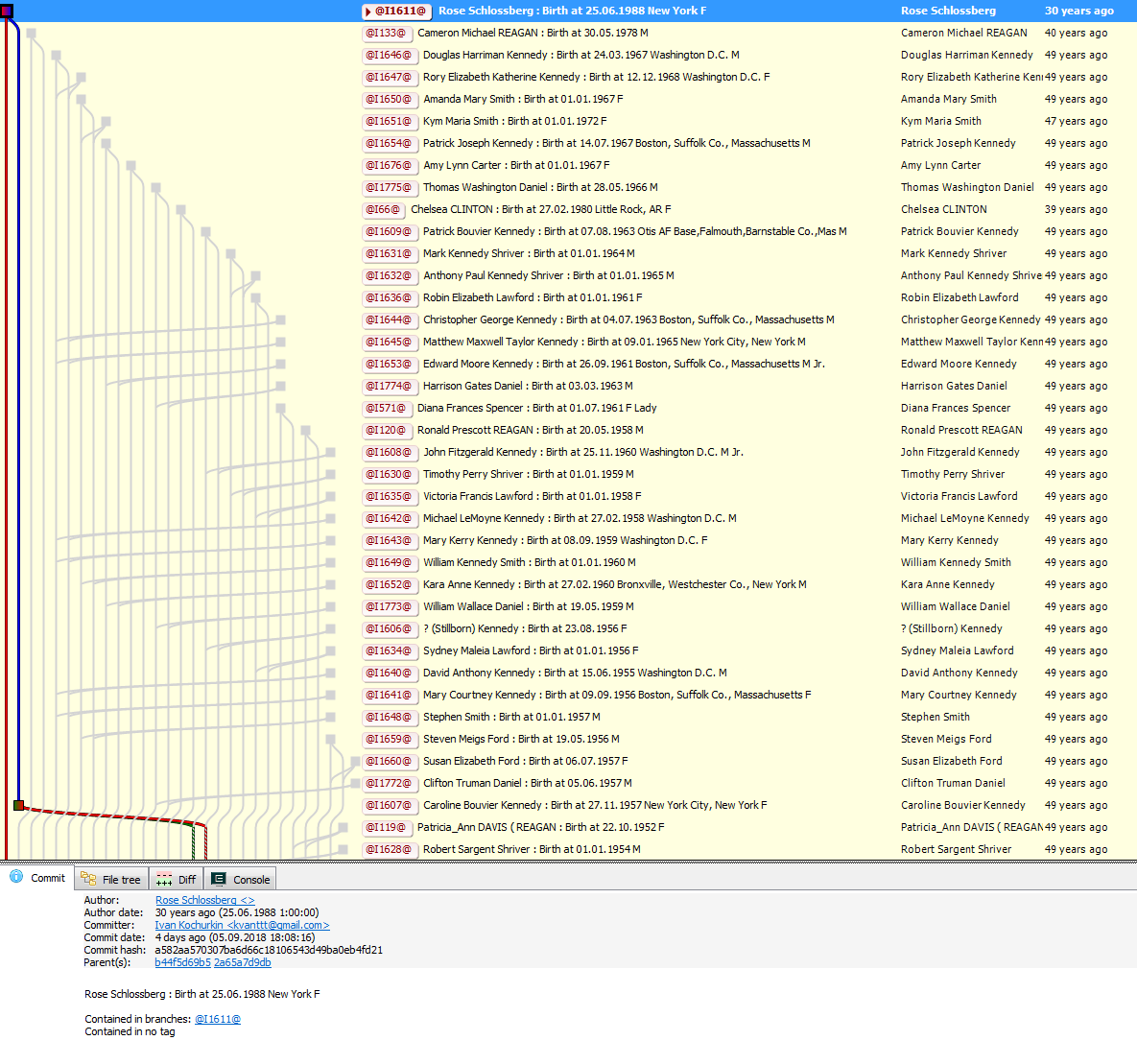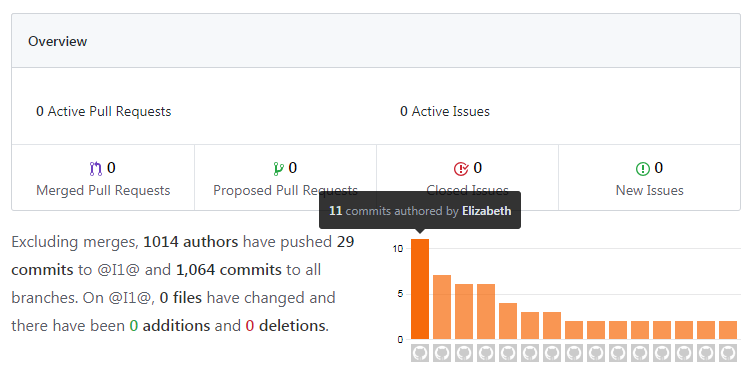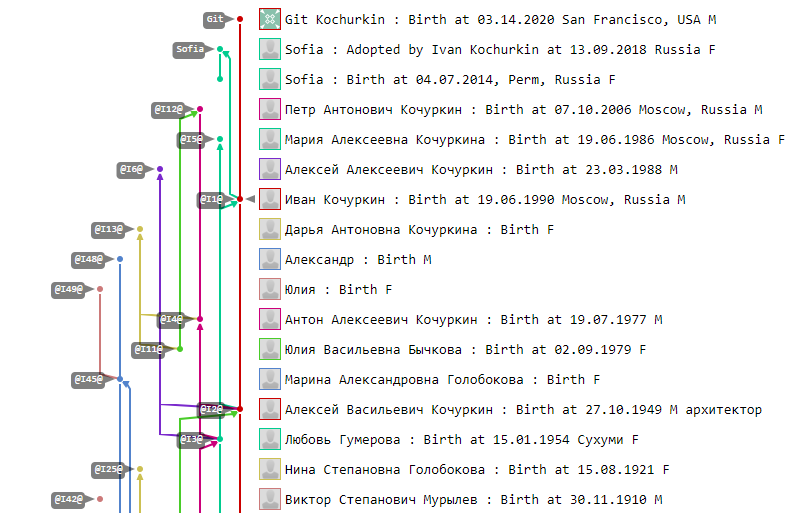Happy programmer's day! I wish you more bright commits, merged pull requests, less merge conflicts, and that your life branches remain relevant as long as possible. As a conceptual gift, I propose the implementation of a family tree by means of the Git version control system. Well… sounds like a plan!
For those who have immediately understood everything, I give links to the source code: GenealogyTreeInGit and family trees: mine and US presidents.
In addition, I implemented a simple social graph. It displays not only the degree of kinship, but also the status of relations between descendants, events such as wedding, divorce, childbirth, as well as contributions to the relations.
Git
| Let me remind you that Git is one of the most popular version control systems. It is powerful: you can commit changes, create (checkout) and merge branches, compare different versions of files (diff), identify authors of specific strings (blame), and do many other things. |
Fortunately or unfortunately, Git is similar to the winner who rewrites history: it allows you to change dates, messages, and authors of commits. But this allows you to add family members, as if they are the authors of events made on a specific date.
I started small: I wrote several commands and voila, a fragment of the tree is ready. Fine. Now we are going to do this with the whole army of relatives. I will be happy to write 200 lines of confusing code for them, and 10K lines for presidents!
Have you already added me to the list of idiots? Strike off. Of course, I automated the process and wrote an application for converting genealogical data to a sequence of Git commands. There are several formats for such data, I chose GEDCOM.
Gedcom
| GEDCOM is a specification for exchanging genealogical data. This format is pretty old, but simple. The specification is well described on the Internet. It is supported by almost all genealogical programs, so there are a lot of examples for it: US presidents, the royal dynasty, Shakespeare. |
I implemented all this mess in .NET Core—it is convenient and cross-platform. For parsing and processing GEDCOM, there are several C# libraries, for example, GeneGenie.Gedcom, gedcomx-csharp. I decided to write my own library based on GedcomParser, because it has a fatal flaw… Actually, no: I just wanted to understand the format myself and get rid of all dependencies, which would allow, if necessary, to easily port the project to other languages.
Command generation
It is time to process the extracted data in a convenient format and generate Git commands for it. I decided to sort all the events in chronological order, and then create branches, merge and commit them in ascending order of dates. Unfortunately, not all events have dates, so it was not easy to sort all the events correctly. 2^2^3 day is coming, and I realized that this approach was not entirely correct, since depth-first search would be much easier. Maybe I will correct it later.
Initialization
At this stage we just initialize the repository:
mkdir Family
cd Family
git initEvents
In this part of the script we process and commit all events. To do this, the following commands were used:
git checkout --orphan branch_namegit merge @I1@ --allow-unrelated-histories --no-commitgit commit -m "msg" --date "" --author "name <email>" --allow-empty
The first command, checkout, creates a branch for each person. The --orphan flag allows you to create orphan branches, i.e. branches without parents. The orphan branch is created once—the next time you switch branches using the checkout command this parameter is omitted. In the end, almost all commits have parents, except the most distant ancestors, as the earlier ones are unknown.
The second command, merge, unites the parents and creates the child. We write "Birth" with the corresponding year in the commit message. We also specify the flags --allow-unrelated-histories and --no-commit to enable merging orphan branches and to commit changes later. Some children are adopted, so we write "Adopted" for them. Funny, but Git allows group marriages, i.e. it is possible to merge more than two branches at a time. And the branches do not have gender, so you can call them "parent 1" and "parent 2". By the way, it is also possible to create single parents.
Finally, the third command, commit, creates a new commit with the message -m, the date --date and the author --author. As I already mentioned, Git allows you to change the message, the author and the date of the commit. Moreover, Git allows you to create commits without files with the flag --allow-empty, and without messages with the flag --allow-empty-message. The author also needs to specify an email, but Git accepts an empty one—you just need to write <>. Unfortunately, Git does not respect the elderly: the lower bound of the date of the commit is January 1, 1970 (the "start" of Unix Time)—the earlier date will be incorrectly displayed. However, you can simply mention the real date in the description. Nevertheless, Git accepts dates in the future—look at my son Git. By the way, it is also possible to create single parents.
Social graph
In the social graph, other events besides birth are also stored: baptism, change of residence, graduation, marriage, divorce, death, funeral. After death the branch goes to digital heaven the appearance of subsequent events, except funerals, is impossible in the branch. On the server, you can make this branch protected (do not worry: it is possible to "resurrect" it in the future, if necessary).
The event "Wedding" has two ancestors—spouses. "Divorce" has one ancestor—the previous "Wedding". Family and parenting is work, so we can say that after the wedding a new descendant also appears—"relationship" which ends after a divorce (or death of a spouse). It resumes after the next wedding. In addition, several people may participate in a relationship (merging several branches).
Finalization
The cherry on the cake: we make a backup repository and upload all participants to GitHub, GitLab, or any other server that supports Git. We can push the branches one by one, but using the magic command we will push them all, which is much faster and simpler:
git remote add origin https://gitlab.com/KvanTTT/Family.git
git push origin --all -uTo generate a common family tree, you need to pass the flag --only-birth-events when starting the generator. In this case, one commit per person (birth) will be created. Otherwise, a social network social graph will be generated.
Examples
As a small example, which will at least work everywhere, I created my family tree, and a large example is the tree of US presidents (2145 people). They are available in the Kochurkins and Presidents repositories, respectively. To create my own tree, I used the service geni.com, from which I exported the tree to GEDCOM. A generated script for creating a genealogical repository is available on Gist.
On GitHub (and GitLab as well), you can navigate through ancestors and descendants. This is similar to genealogical wiki systems Familypedia or WeRelate. However, GitHub/GitLab is more advanced: the trees are easily downloaded from it (with the help of the --clone command). And most importantly, you can open the entire graph at once. (In existing genealogical programs, for some reason, there are difficulties with opening even small graphs.) And you can do this using different tools (web service, Git Extesions, Sourcetree, GitKraken and others). In addition, these services can be used for free, unlike most of genealogical services.
It is noteworthy that on GitHub/GitLab even some sort of analytics is available: you can find out who has the most followed Instagram account eventful life. Or the most public: the Insights tab displays a list of people in order of decreasing number of commits.
Unfortunately, GitHub and GitLab do not display large trees correctly, but they are stored properly—you can open the repository and check. Here is my tree in the GitLab web interface:
Problems
It is not very clear how to complement history from the roots. For now you have to generate it from the beginning from the GEDCOM file. Probably this can be done with the help of rebase—you can try and tell in the comments. It would also be better to rewrite the code to make it "commit-oriented", not "event-oriented", because it is more Git-like: in fact, the branch is a sequence of commits, not a separate entity. I also thought about implementing tags and submodules, but for now I don't know how to do it better.
Conclusion
If you extend the idea of family trees further to web services for developers, then using issues you can create global tasks and distribute them according to milestones: childhood, youth, adulthood, elderhood.
Besides family trees, you can use Git to encode genealogical trees of programming languages (this is even more geeky), syntax trees, and any tree structures. Git can also be useful for housewives to build relationships between the characters of Brazilian soap operas :)
Practical benefit: this warm-up helps to better understand the structure of Git, its commands, and the GEDCOM format for describing genealogical data.
The sources of the article are available on GitHub — please send Pull Request if you find any mistake or want to add something. For converting to habr.com format, I use the library MarkConv.




